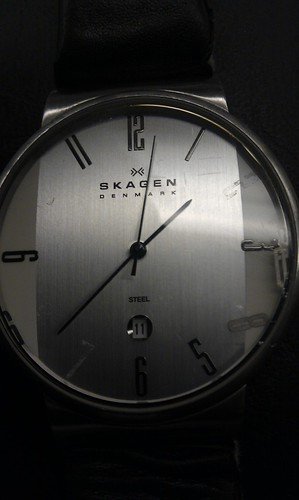Just a couple of cogitations – hopefully worthy -- about technology and our relationship with it.
Analogue or digital?
Is there any advantage in having an analogue watch face to a digital one, or vice versa? I had a friend once who said he was unable to read my new digital watch (this was when they first became must-have accessories), and I thought he must be joking. I mean, who can’t read numbers?
It’s a numbers game! Photo by Terry Freedman
The time is out of jointBut since then I have heard that there are younger people who can’t tell the time from an analogue watch face. I cannot believe that either, to be honest. Perhaps it’s one of those urban myths, propagated by some sort of digital watch face promotion society.
One advantage of analogue is that if the numbers disappear, as long as the hands still work you can continue to tell the time. On the other hand, when the numbers on a digital watch face decide to down tools, all you have on your wrist is a useless piece of junk.
This will appear to you to be a completely pointless point to make, if you’ll forgive the oxymoron. However, a close look at my watch, shown in the photo, will disclose the fact that this became a very real issue for me yesterday. I dropped my watch, and some of the numbers fell off. Ridiculous. But I can still tell the time. That’s the advantage of a good education.
And an analogue watch face.
A step in the wrong direction
I try to go swimming a few times a week. There’s a machine in the men’s changing room that measures your height, weight, body mass, BMI, and probably loads of other stuff. It even gives you a print-out of all these measurements. I had this idea that I’d go through this measuring process once a month so I can track progress towards one of my goals, that of losing some weight. I would even enter the numbers on a spreadsheet and get a graph, percentage decreases, and anything else I could derive from them in order to aid my motivation.
Unfortunately, I think the machine is faulty. After a month of hard graft, everything has gone up slightly. For example, I have put on one pound. I have heard that one pound is not significant either way. I have heard that developing more muscle makes you put on weight.
I have heard that the machine never lies.
So what?
The common theme in these two stories is, I think, that developments in technology are not unequivocally good, or even accurate in any meaningful way. For example, I am told that my watch will lose only one second in three million years. I’m an education technology consultant, not an atomic scientist: why would I be concerned about that degree of accuracy? How do they even know that figure is accurate? And what does it mean for my consumer rights should the watch lose two seconds in the next three million years? See what I mean? It’s meaningless, and pointless.
As for machines in sports centres, everyone I know who runs has told me that the work-out provided by a treadmill is nowhere as hard as a run of the equivalent length, incline and intensity. (That sounds about right to me: running for a bus is infinitely harder than running on a treadmill.)
There’s an understandable inclination to believe “objective” technology, and to come to rely on it, but I think that if we do little else we would do well to help instill in young people a healthy scepticism about how accurate technology really is sometimes, and why that might not even be meaningful in any real sense.
I think there are many areas in the ICT curriculum, as well as in the broader curriculum, where asking the question "So what?" may pay dividends.
If you found this article interesting or useful (or both), why not subscribe to my free newsletter, Digital Education? It’s been going since the year 2000, and has slow news, informed views and honest reviews for Computing and ed tech teachers — and useful experience-based tips.

